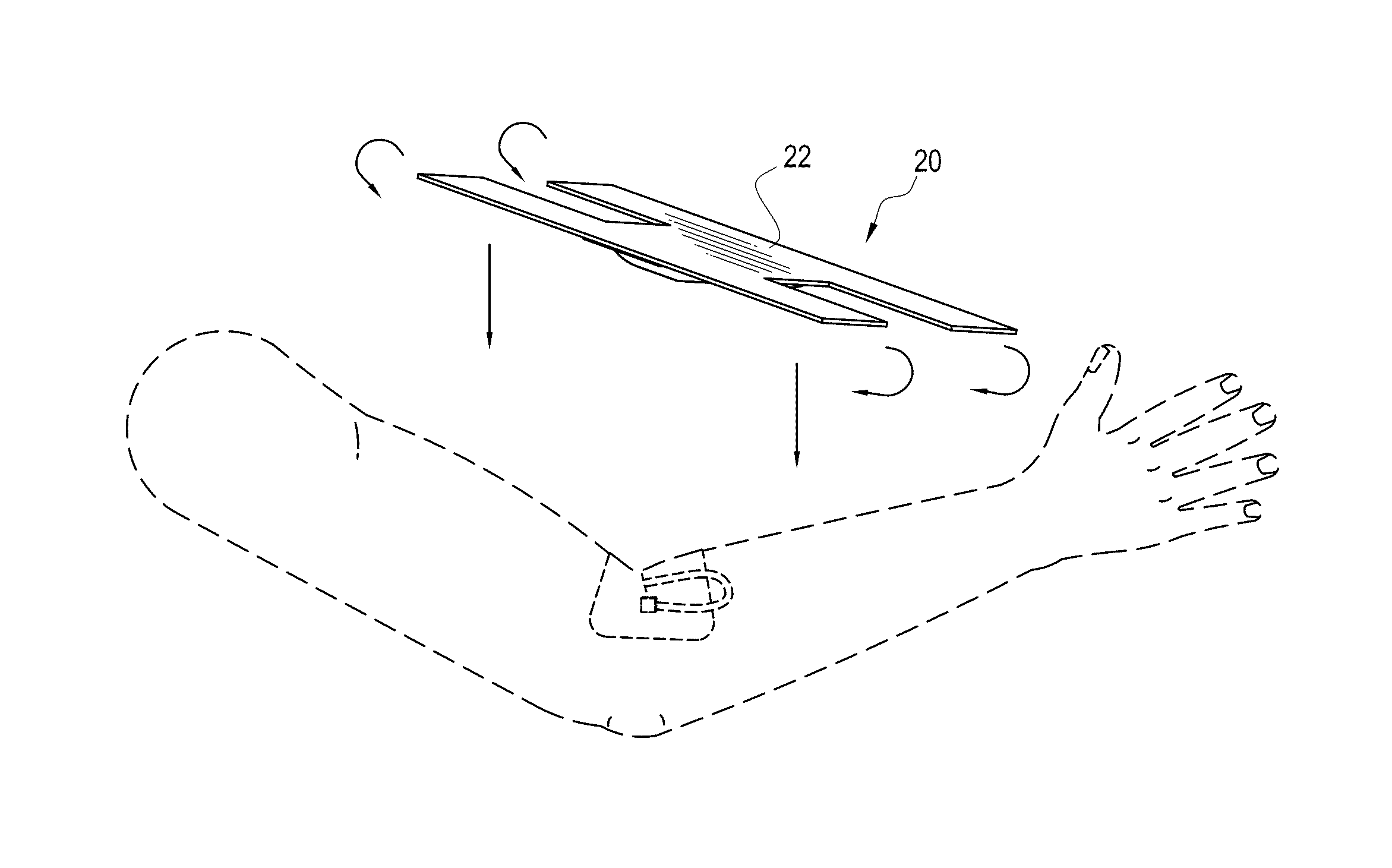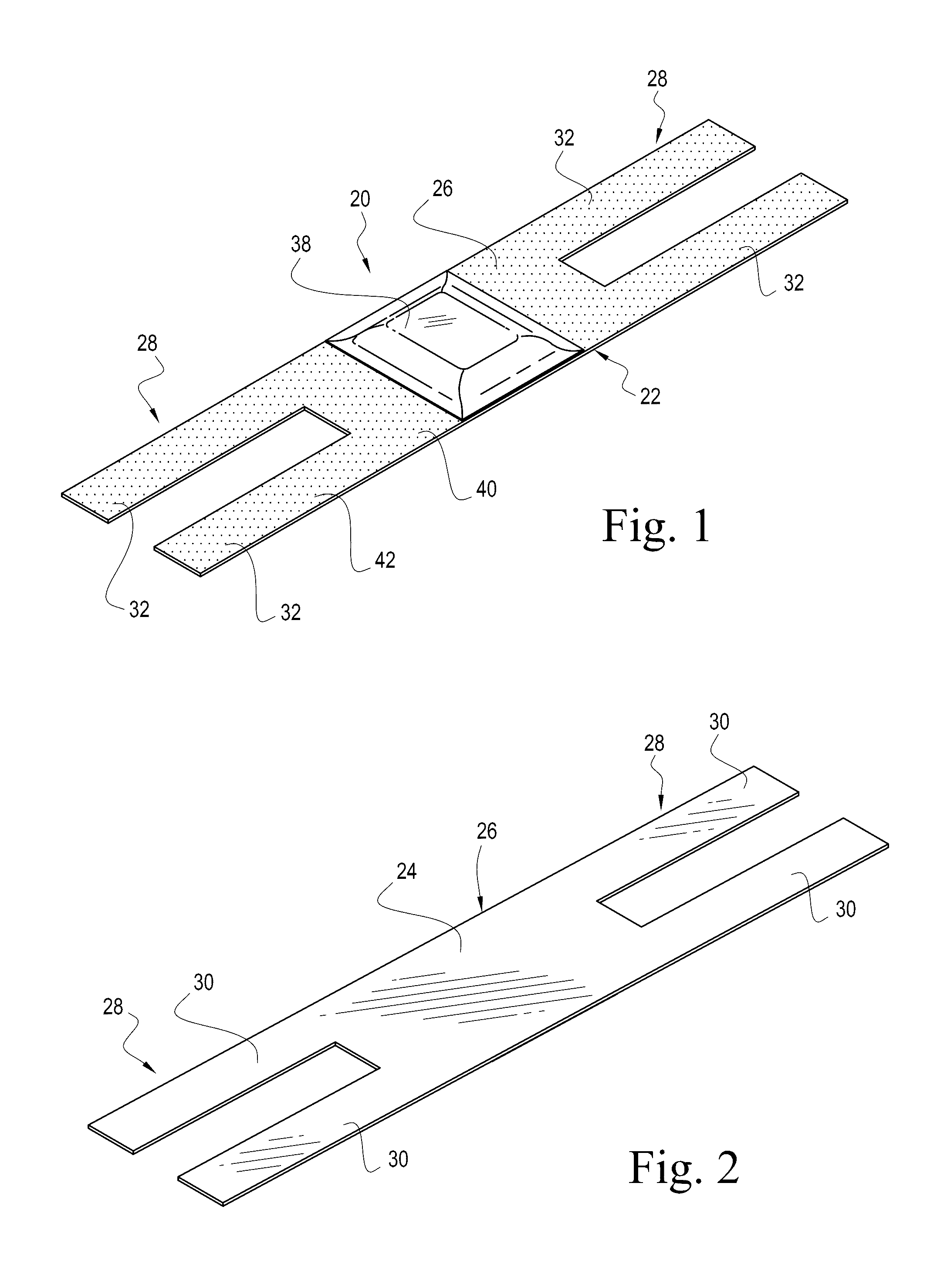It can sometimes be uncomfortable when patients require
medical treatment that involves an intravenous line (IV).
Although IV medical treatment is very common, and is a routine way to deliver medication, the starting of an IV is generally a process that many patients do not like, i.e., being stuck with a needle.
In some instances, an IV may come out, i.e., require reinsertion, thereby causing discomfort to the patient, and exposing the patient to possible infection.
Another issue that may arise is
occlusion of the IV due to the bending of an IV tube.
Accordingly, use of the splint disclosed in the Lewis' 913 patent immobilizing a patient's extremity and can be uncomfortable for the patient.
Further, in cases where a patient may have
edema, such devices do not stretch, which may cause fluid collection and clotting, which can, in turn, be problematic.
Accordingly, such device can be uncomfortable for the patient to wear on receiving IV treatments.
This device can also impede circulation by
constriction and limited extremity movement.
Such a device may, however, be uncomfortable for patient, and may still inhibit flexural movement of the patient's extremity.
This device's only purpose is to prevent dislodging of the
catheter, needle, etc. and does not prevent bending or kinking of the
catheter, needle, etc.
Further, the device illustrated in the Bierman '001 patent may be expensive to manufacture.
This device is made of uncomfortable materials, such as metals and plastics.
Such a
system depicts the very problem that needs to be addressed, i.e., immobilization of the extremities of the patient, thereby causing discomfort.
This can be an issue with patients that may suffer from
dementia who may attempt to rip out an IV, or young patients that may be anxious from the
sight of the IV.
In addition, such a device may still inhibit flexural movement of the patient's extremity.
This device is a clear dressing with an anchor to prevent dislodging of the
catheter, needle, etc. and does not prevent bending or kinking of the catheter, needle, etc.
Further, the device may be expensive to manufacture.
Such a device may, however, be uncomfortable for the patient, and may still inhibit flexural movement of the patient's extremity.
Further, the device may be expensive to manufacture and may require specific tubing, catheters, needles, etc. so that they can matingly engage the device.
Another
disadvantage of the Bierman device is that it still allows for a patient to readily view the IV site, which causes the same issues referenced above with respect to the Propp reference.
This device is used to prevent dislodging of the catheter, needle, etc. and does not prevent bending or kinking of the catheter, needle, etc.
The device in Chong, however, discloses applying a stronger
adhesive to different areas of the base of a
medical device, but not to the securing members when they are separate from the main body.
In addition, Chong is not an intravenous splint cover and does not allow any flexural movement of a patient's extremity when a catheter, needle, etc. is in place.
This device is an anchor and does not protect the catheter, needle, etc. or the IV site.
The device disclosed in Grubb cannot be used over an intravenous site as it will prevent the flow of fluid through the IV line and into the patient.
Cesarczyk suffers from the same defects as the '448 Grubb reference in that it is inappropriate for use in connection with the delivery of fluid through an IV.
This device, along with the device described in the Grubb reference, are inappropriate for simultaneous use with an IV and / or IV therapy.
When a patient bends his / her arm, however, or any adjacent extremity to an IV site, shifting, kinking or bending of a flexible catheter, needle, cannula, flexible tube, etc. in the
vein located in a bend of the patient's extremity is not addressed by any of these devices.
Compression of the catheter, needle, cannula, flexible tube, etc. against the vessel wall is also a problem with these devices.
In addition, in the prior art, the IV site is either covered so that it is not accessible and / or viewable, without the ability to view or palpate, covered with a transparent material, or not addressed by the prior art device.
No flexibility exists in these viewing conditions.
The devices described above, and other devices that may be known in the art generally suffer from the same deficiency, i.e., the devices prevent the patient from being able to move their extremity.
Patients that are uncomfortable while receiving IV treatments may not respond as well to treatment as patients who are comfortable.
 Login to View More
Login to View More  Login to View More
Login to View More 


